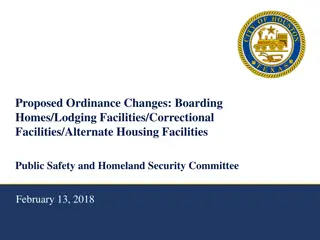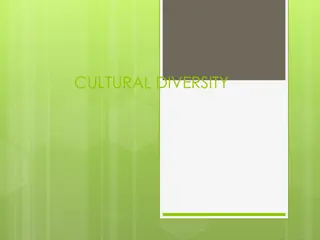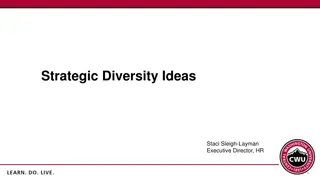Proposed Changes to University's Diversity Requirements: A Comprehensive Overview
The Committee on Undergraduate Education (CUE) has been tasked with revising the Comparative Gender & Multicultural Studies General University Requirements (GURs). Key proposed changes include increasing credit requirements, reorganizing courses, introducing diversity-equity-justice designations, and adopting a developmental approach to understanding diversity. The CUE has engaged with various campus stakeholders and groups to evaluate and advise on these recommendations to enhance diversity curriculum and requirements.
Download Presentation

Please find below an Image/Link to download the presentation.
The content on the website is provided AS IS for your information and personal use only. It may not be sold, licensed, or shared on other websites without obtaining consent from the author. Download presentation by click this link. If you encounter any issues during the download, it is possible that the publisher has removed the file from their server.
E N D
Presentation Transcript
A Working Draft for Revising the Comparative Gender & Multicultural Studies (CGM) General University Requirements (GURs) Presentation to the Faculty Senate 11-16-20 From the Committee on Undergraduate Education (CUE)
In their 2016 report, Recommended Improvements to General Education the GURs, ACC put forward 4 priority areas for improvement: writing, diversity coherence, and more faculty-student engagement through smaller classes.
In terms of diversity, ACC proposed that the university: 1. Increase the current minimum credit requirement for HUM and SSC from 24 credits to 34 credits (from 12 to 17 credits for each of the two areas). 2. Move the GUR courses currently listed under either ACGM or BCGM to either HUM or SSC, as appropriate. 3. Require that students take at least two courses with a diversity-equity-justice (DEJ) designation, indicating that the course meets the university guidelines for addressing, in some deliberate form, the study of human diversity and of systemic equity and justice-related issues arising from the experience of diversity. 4. Consider the question posed by the 2016 General Education Task Force: How could we adopt a developmental approach to understanding diversity, giving our students an initial understanding of foundational diversity concepts, followed by an opportunity for students to explore them in more depth?
In fall 2019, ACC charged CUE to complete the following tasks: (1) Evaluate the recommendation for revising Western s diversity requirements. (2) Advise on the feasibility and sufficiency of the proposed approach by engaging in broad consultation with campus stakeholders. (3) Explore and advise on means and models by which a more developmental approach to diversity curriculum and requirements might be introduced. (4) Deliver one or more plans outlining a proposal for implementation of changes to existing diversity requirements. At least one proposal must utilize existing resources. (5) Include an outline of any new resources without which the (preferred) plan cannot be viably implemented.
Until the University shut down last March, CUE had spoken with the following individuals and groups Ethnic Students Coalition Student Ambassadors from the College of Science and Engineering (CSE) and follow-up meeting at CUE with Kristopher Aguayo & Elias Bashir CHSS Deans and Chairs Committee (DAC) CHSS Faculty Affairs Council (FAC) CFPA Deans and Chairs Committee (DAC) Vicki Hsueh, Director of Women, Gender, and Sexuality Studies (WGSS) L.K. Langley, LGBTQ+ Director Libraries Teaching & Learning Brown Bag group Fairhaven College Faculty and Staff meeting Shevell Thibou, Social Justice & Equity Committee
Other Documents & Events that Influenced CUEs Deliberations The list of current ACGM and BCGM courses and their catalog descriptions. The 2016 General Education Taskforce report. The language in the university s Strategic Mission and Plan. The university s support for the decision package for an Ethnic Studies Academic Initiative. The 6/22/20 letter from Black Student Organizations. The President s recent solidarity message, which accompanied his Diversity, Equity, Inclusion Timeline, in which he expressed a desire to work with the Ethnic Studies Collective (faculty and students), and others as appropriate, to support development of curricula and programming and also add a General University Requirement focused on African American studies and structural anti-Black racism. The situation unfolding in the California State University system regarding a new proposed Ethnic Studies and Social Justice requirement. The national response and protests in the aftermath of the murder of George Floyd Research into similar requirements of other university programs.
Separating Diversity from Equity/Justice The original CGM requirement was framed with diversity understood as multiculturalism, which is, by most current educational perspectives, a concept that has run its course. In considering the name and purpose of this requirement, CUE sought to decouple systemic equity-and-justice-related issues from the study of diversity. Diversity courses and equity-justice courses ask fundamentally different questions, are concerned with different issues, serve different purposes, and produce different outcomes.
Diversity asks, Whos in the room? Equity responds: Who is trying to get in the room but can t? Whose presence in the room is under constant threat of erasure? Inclusion asks, Has everyone s ideas been heard? Justice responds, Whose ideas won t be taken as seriously because they aren t in the majority? Diversity asks, How many more of [pick any minoritized identity] group do we have this year than last? Equity responds, What conditions have we created that maintain certain groups as the perpetual majority here? Inclusion asks, Is this environment safe for everyone to feel like they belong? Justice challenges, Whose safety is being sacrificed and minimized to allow others to be comfortable maintaining dehumanizing views? (from Dafina-Lazarus Stewart, link to article in full draft).
The Name: Power, Liberation, Equity, Justice (PLEJ) Equity and Justice are goals which the university is currently working to promote. Power Liberation Equity Justice Power and Liberation replace the term Diversity. Learning to recognize the ways that social, economic, and political power is sustained through individual beliefs and actions and institutional practices and policies, in turn, empowers students with understanding and agency.
A Developmental Sequence: PLEJ-1 PLEJ-1 courses introduce core concepts and theories for understanding various systemic and structural forms of power, discrimination, and oppression that sustain social, economic, and political inequities in the United States. PLEJ-1 courses serve as a foundation for and prerequisite to a second, specialized or applied set of courses (PLEJ-2).
A Developmental Sequence: PLEJ-2 PLEJ-2 courses give students an opportunity to extend, deepen, and apply the knowledge they have gained in the foundational course. These courses could focus on specific identities, cultures, events, organizations, institutions, policies, texts, etc. in the U.S. and/or the larger world. The goal of PLEJ-2 courses would be for students to utilize the knowledge gained in their PLEJ-1 course to examine and analyze specific groups, topics, events, and situations, using the theoretical lenses they are beginning to acquire.
Distinctions between PLEJ-1 and PLEJ-2 courses In PLEJ-1 courses, the concepts and theories form the primary subject matter, and the topic serves to focus and illuminate students understanding of how these theories work. In PLEJ-2 courses, the topic forms the primary subject matter, and the concepts and theories support the learning of the topic of the course.
Two Models for the Foundational Course (PLEJ -1) Model A: PLEJ-1 courses would use race, racism, and anti- racism in the U.S. as the primary lens to learn and understand concepts and systemic theories of power, discrimination, and oppression. Model B: Any marginalized or underserved social community or identity group in the U.S. could serve as the primary lens for examining concepts and systemic theories of power, discrimination, and oppression; for example, courses that focus on gender, sexuality, religion, disability, etc.
Intersectional Comparison of Model A and Model B Gender Race Appearance Appearance Sexuality Sexuality Race, Racism, Antiracism in the U.S. Gender & Power in the U.S. Language Ability Language Ability Class Religion Class Religion Model A: Race, Racism, Anti-Racism Model B: Any Marginalized Social Group or Identity Category
PLEJ -1 Model A Narrower focus Fewer number of current courses that could fit or be adapted to the requirement Show strong support for concerns forwarded by BIPOC students, faculty, & staff by ensuring that all students who complete the entirety of their education at Western will have taken at least one course in race, racism, and anti-racism PLEJ -1 Model B Wider focus Greater number of current courses that could fit or be adapted to the requirement Students could graduate without having a course in race, racism, and anti-racism
Three Alternatives for Structuring the Requirement Structure 1: Create a new PLEJ GUR category. The CGM GUR would be replaced with a new PLEJ GUR category. Students would take a PLEJ-1 and PLEJ-2 course just as they now take an ACGM and BCGM course. While some current CGM courses could become PLEJ courses, this version also opens opportunities for other interested departments inside and outside of CHSS to propose PLEJ courses. Credit requirements for the humanities and social sciences would remain at their current levels (12 credits or 3 courses).
Structure 2: Label specific GUR courses with PLEJ tags. Label qualifying GUR courses with a PLEJ-1 or PLEJ-2 tag. Increase the humanities and social science credits from 12 credits to 16 credits, or from three courses to four courses each, since it is likely that most of these courses would come from humanities and social science GURs. This structure would also allow students to take as many PLEJ courses as they wish to fulfill their Humanities and Social Science requirements (as long as students do not take all of their courses from the same department).
Structure 3: PLEJ-1 GUR course + PLEJ-2 tagged-course PLEJ -1 would be a standalone GUR course and PLEJ-2 would become a graduation requirement that students could fulfill by taking either a tagged GUR course or a tagged course in the major. While no department or college would be required to offer PLEJ-tagged major courses, allowing for the possibility does open opportunities for departments. Some students have suggested that adding courses in the major could help them develop their academic and professional identities by understanding how systemic inequities play out in their fields. Structure 3 incentivizes the creation of these types of courses. Making the second course a graduation requirement would also make this a requirement for transfer students with DTAs who are exempt from WWU GUR requirements.
A Phased-in Approach to Implementation (Full Implementation 2024-2025) Phase A Sampling of Tasks Preliminary Phase 2020-2021 Phase 1 2021-2022 S: Approve selected changes; begin developing X97 temporary PLEJ courses Sum: Begin offering opportunities for professional development F: Departments inventory CGM courses for suitability/desirability for PLEJ courses W/S: Begin developing/proposing PLEJ-1 courses Sum: Continue offering professional development F: Begin offering some PLEJ-1 courses and moving non-PLEJ courses to Hum/SSC F-W: Begin developing PLEJ-2 courses Sum: Continue offering professional development Phase 2 2022-2023 Phase 3 2023-2024 Begin phasing out temporary PLEJ courses F: Full implementation of PLEJ-1 courses for new students; begin offering PLEJ 2 courses as an alternative to A-CGMs W-S: Migration of most remaining CGM courses to HUM/SSC or other GUR Phase 4 2024-2025 PLEJ 1 and PLEJ 2 requirement in full effect for all new students
Some In the Meantime Measures: CUE will continue its effort to create a database of current courses that do this work. Encourage departments to test the waters by developing temporary (x97) courses that might become PLEJ courses. Encourage departments to consider opportunities for exploring the desirability of creating PLEJ-like courses in the Major.

























